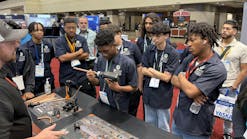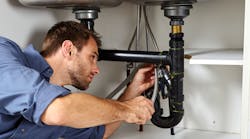I was asked to speak to about 200 plumbers last month on the subject of employee retention. Typically, I look around the industry to see who is successful in that particular way. I know several contractors in HVAC, electrical and plumbing who have had high success. By success, I mean employees who have been with them for 20 or more years. I’d call that success. But I saw about 10 times more contractors who struggled to keep someone for over 5 years.
I have always said that employees leave the job for two reasons:
1. The boss is a jerk.
2. The boss is a greedy jerk.
Now before you throw this magazine across the room, hear me out and please open your mind. There is a good reason for the huge exodus of skilled labor for “in-home service” contractors. I hate to name names, but the name of the reason is Flat Rate Pricing. Yes, many of us hailed flat rate pricing as the answer to life and the solution to our money problems in the service department, but there are three very good things that flat rate pricing did for us, and three very bad things that flat rate pricing did to us.
Three good things:
1. Allowed us to give up-front pricing.
2. Allowed us to develop a “no surprise” policy for the customer.
3. Allowed us to get paid on the spot, eliminating almost all of our accounts receivable problems.
Many say, “Yes, but it also brought in more money.” Well, in a way it did, and in a way it did not.
Here are three things to consider:
1. When we went to flat rate system, we added a diagnostic/service charge. This alone, all by itself, doubled the average ticket for most contractors in the early 90s. This was a freebie, not flat rate pricing; this was just what the car business calls a “Dealer Add-On.” You know, like a destination charge or setup charge. For example, I recently bought a Yamaha Grizzly 700 ATV. The dealer added a “set up” charge, which he said was for assembly. I had to laugh out loud. I have been to the factory and guess what? They are completely assembled and test run before they are crated and shipped to the dealer. What the dealer should have said was “$395 Uncrating Charge.”
So, dealers added additional profit, and so did we. We called it a service charge, or a show up charge, or a “service and dispatch charge.” It’s just more money. And boy, what a difference it made!
2. When we went to flat rate pricing, most of us raised our prices by 25% or more. The service charge was now hidden, so to speak, in the flat rate fee.
3. The big advantage was we got to hide the labor charge, which back in the day, was the one thing the customer was most likely to complain about.
Now, what does all of this have to do with the title of this article and getting your techs out of sales?
Well, you may not know this, but flat rate pricing is what got your techs into sales in the first place. Before flat rate pricing, the tech did not need to discuss money, explain costs or, and this is very important, collect the money.
When the technician gave the up-front price and there was a price complaint, it was made to him/her – the tech had to take the heat for the price. So, what happened was we now had to track “lost sales” or “lost service calls” or “technician closing rates.”
What it meant was that when the tech gave the price, the customer often sent them packing.
And when they did get the job, the customer rarely asked the tech to do more work so something new was invented.
Okay, here’s three very bad things that flat rate pricing did to us:
1. Gave the techs a price book—and this gave them a taste of being in business for themselves.
2. Sales training chased off our best, most respected techs. They either went to our competitors or became our competitors.
3. It put the focus on the parts and the blame on the tech.
Here’s the process for training your technicians:
1. Put the tech in a sales communication class.
2. Tech resists.
3. Give the “money incentive.”
4. Tech tries, fails, then tech resists again.
5. Give more sales training.
6. Tech gets poor results.
7. Fire tech and hire the copy machine repairman.
8. Call backs happen.
9. Kick the copy machine guy in the rear and tell him to get smarter.
10. Copy guy goes back to copy machine sales.
11. Hire for attitude (the attitude to sell and make money, that is).
12. Train for aptitude.
13. Results: Pretty much the same as the copy machine guy.
14. Hire competitor’s techs for higher pay and bigger promises.
15. Give incentives, perks, bonuses, performance pay.
16. Results: Spend a heck of a lot of money, pain and frustration to find out that techs don’t sell, won’t sell and will leave you if you try to make them sell.
17. Result: Twenty times more competitors today than there were twenty years ago, and companies can’t find techs.
Last month, I told 200 plumbers the same thing I’m going to tell you now. Pay like the government and medical professions, then make the job a process. Train technicians to follow the process.
In other words, make the job a shoe and let the tech slip into the shoe.
1. Diagnostics
a) Choose the diagnostic chart for the equipment you are diagnosing.
b) Follow the chart.
c) Call your manager if you get stumped.
d) Anyone with some common sense and an ability to use a screwdriver and a tester can do that. If you don’t believe it, watch YouTube and see how many “unskilled people” do just that.
2. Repair
a) Part replacement is easy-peasy. Just follow the checklist.
b) Higher levels like refrigerant adding or replacement, leak repair, brazing, etc. require a chart. You can train someone to braze in one or two weekends.
c) Train for performance tuning of equipment, air ducts, etc.
3. Did you know (I know you know this) that when a man joins a union for a skilled trade, he starts out at a sensible pay (usually what you pay your techs), and then he goes to school two nights a week for up to five years? How much training do you do?
I could elaborate; I could point fingers; I could pretend I know it all, but it all comes down to this: Quit paying for sales and start paying for eight solid hours a day. Quit griping that techs are dumb and start training like every other industry in the world. Quit thinking the tech is supposed to solve your problems by selling. Selling is your job—find a way to do it.
Want more information? Call or email: Rodney Koop, Founder, www.TheNewFlatRate.com; email [email protected] or call 706/581-0622, anytime.
Pricing enthusiast Rodney Koop is the founder and CEO of The New Flat Rate, a home service menu-selling system designed to put profit directly into the hands of plumbing, electrical and HVAC contractors.









